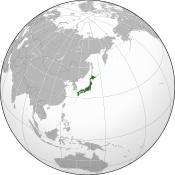Japan changes Iwo Jima's name
Friday, June 22, 2007


Iwo Jima, a Japanese island known for one of the deadliest World War II battles and an iconic raising of the United States flag by U.S. soldiers, is now known by another name, or its old name to be exact.
Renamed Iōtō (pronounced "ee-woh-toh") as preferred by the island's original residents, the official designation was adopted on Monday by the Geographical Survey Institute of Japan and the Japan Coast Guard, the Associated Press and other news outlets have reported.
Meaning "Sulfur Island", the small volcanic island's name was changed in 1944, ahead of the U.S. invasion, when civilians were evacuated. Some officers of the Imperial Japanese Navy arrived to fortify the island ahead of U.S. forces, and mistakenly called it Iwo Jima. In Japanese, "jima" is an alternative word for island. In kanji script, the writing of Iwo Jima and Iwo To is the same; only the pronunciation is different.
U.S. forces took the name Iwo Jima when they made the island their first toehold in the Japanese Home Islands, and after a fierce battle and an iconic flag raising on Mount Surabachi, the island's highest point, the name of Iwo Jima was burned into popular-culture consciousness.
Last year, American actor-director Clint Eastwood released a pair of films depicting the World War II battle, Flags of Our Fathers, telling the American side of the battle, and Letters from Iwo Jima, from the Japanese viewpoint. The films further cemented the island's name, and made original residents more resolved to change the name back to Iwo To.
"Though we're happy for Iwo To, which has been forgotten by history, the islanders are extremely grieved every time they hear Iwo To referred to as Iwo Jima," a local newspaper quoted the villagers' resolution as saying.
During the war, about 22,000 Japanese troops dug into heavy fortifications, and fought against the 100,000-strong U.S. forces. Fewer than 1,000 of the Japanese soldiers survived, and about 7,000 U.S. troops were killed. During the battle, the raising of the U.S. flag by group of Marines was photographed by Associated Press photographer Joe Rosenthal. The image went on to become one of the most iconic of the war, and was used to create a memorial to U.S. Marines in Washington.
After the war, local residents were not allowed to return to the island. The U.S. continued to occupy the island until 1968, and today it is used as a base for Japan Self-Defense Forces and visiting U.S. Navy personnel.
The island is part of the Ogasawara Islands chain, which are mostly uninhabited. Only Chichi-jima and Haha-jima support local populations. Though it is about 1,120 kilometers (700 miles) south of Tokyo, the island chain falls under the administration of the Tokyo metropolitan government. In March, officials adopted the resolution that changed Iwo To's name, after Ogasawara residents and descendants of Iwo To evacuees submitted a petition. The Japanese central government agreed, and an official map with the new name will be released September 1.
Though the island's evacuees and descendants are happy about the decision, some former soldiers are not.
"Naval maps have long used the name Iwo Jima," 84-year-old Kiyoshi Endo was quoted as saying by the Associated Press, in a translation from Japan's Sankei newspaper. "We should respect that history," said Endo, who leads an association of Japanese veterans of the Battle of Iwo Jima.
Retired U.S. Marine Major General Fred Haynes, who was captain in the Marine regiment that raised the U.S. flag on Mount Suribachi, said the island's name change saddens him.
"Frankly, I don't like it. That name is so much a part of our tradition, our legacy," Haynes was quoted as saying by the Associated Press (AP).
Haynes, 85, is the head the Combat Veterans of Iwo Jima. Each year, the group of about 600 veterans travels back to the island for a reunion.
Haynes is also working on a book about the battle, "We Walk by Faith: The Story of Combat Team 28 and the Battle of Iwo Jima." He doesn't plan to change the name, he told the AP.
"It was Iwo Jima to us when we took it," Haynes said. "We'll recognize whatever the Japanese want to call it but we'll stick to Iwo Jima."
Sources
[edit]- Justin McCurry. "Change of name for Iwo Jima" — The Guardian, June 21, 2007
- Associated Press. "Japan gives Iwo Jima pre-war name" — CNN, June 21, 2007
- Press Release: Gsi. "硫黄島の呼称を「いおうじま」から「いおうとう」へ変更" — Geographical Survey Institute of Japan, June 18, 2007 (Japanese)




